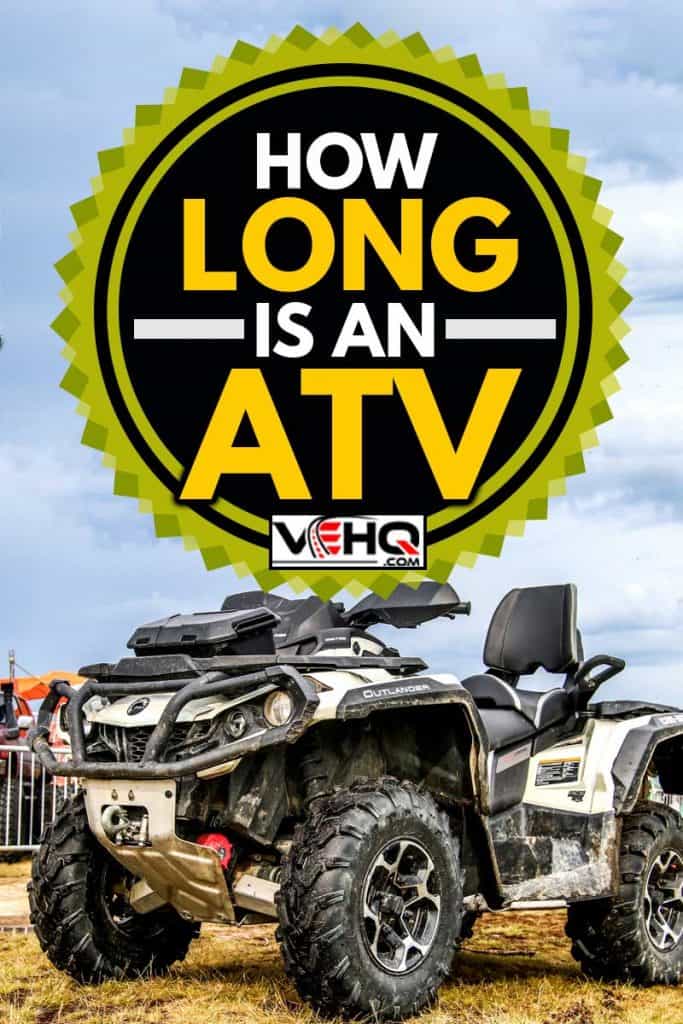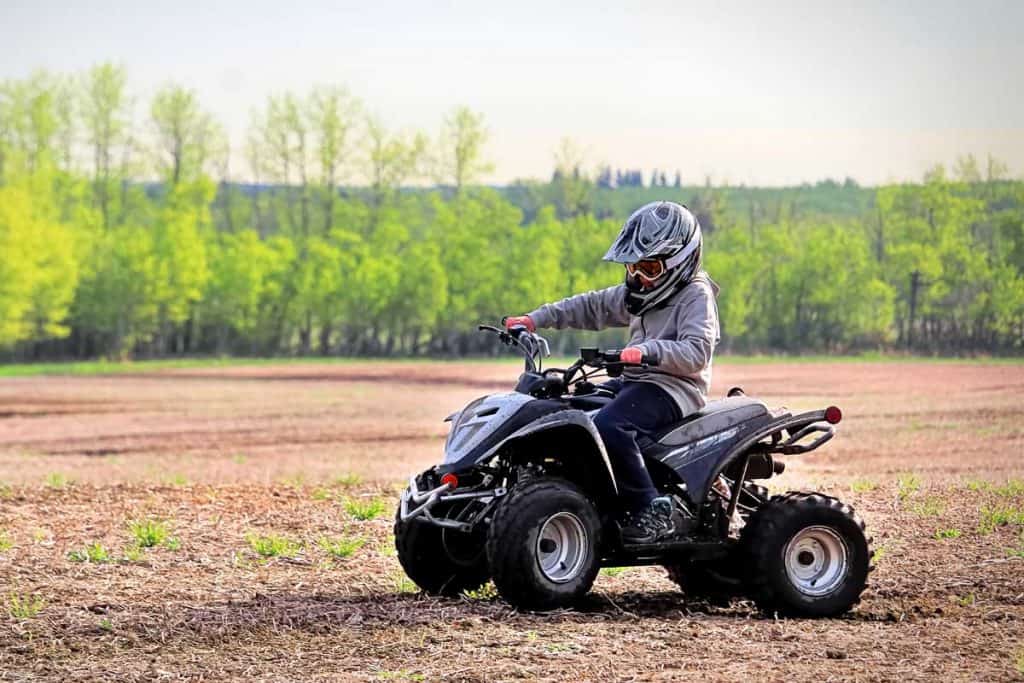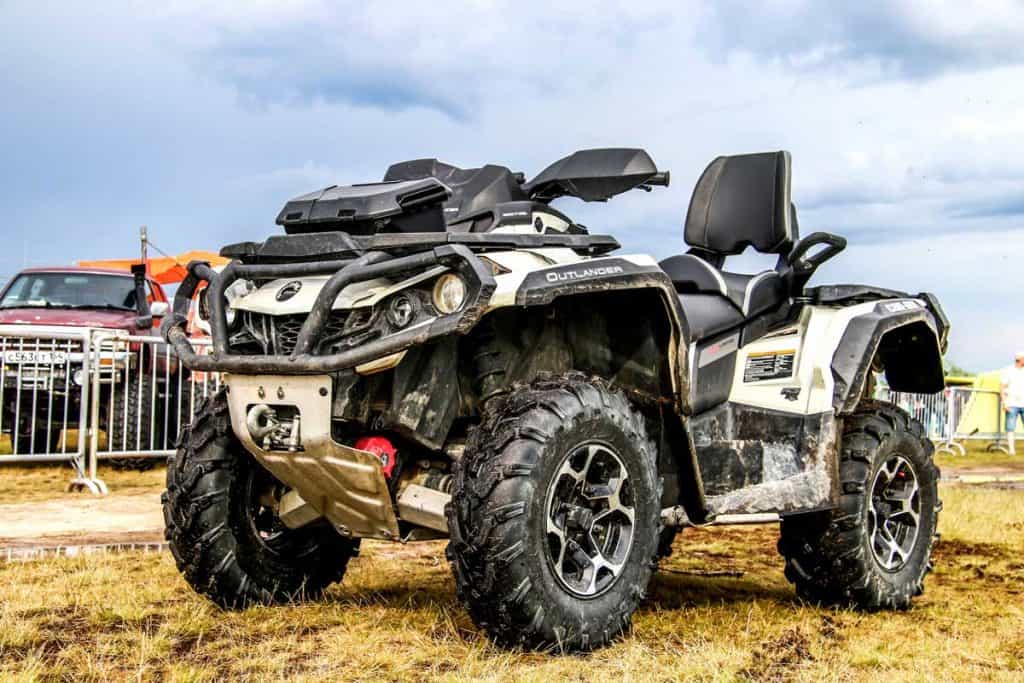The length of an all-terrain vehicle (ATV) is important for a few reasons. If you've been thinking about buying an ATV, you may be wondering how to figure out which length is right for you or your family. ATVs are great for various activities on almost any terrain, and there are several differences between ATV models that can impact performance, length included!
A standard ATV can be 70–90 inches in length, with most being between 80–85 inches long. Typically as the length increases, so too do the width and engine sizes. Various models have different specifications, so one vehicle may be better suited for a particular activity than another. Take the lengths of these different ATVs, for example:
- Polaris Sportsman 450 HO ATV - 83 inches
- Can-Am Outlander 850 XT-P - 86 inches
- Honda Four Trax Foreman Rubicon 4x4 - 84.5 inches
- Kawasaki Brute Force 750 4x4i - 86.4 inches
- Yamaha Grizzly EPS XT-R - 81.5 inches
- Suzuki King Quad 750 - 84.6 inches
As you can see, the length varies a few inches between most standard-sized models. It's essential to pay attention to each model's specifications when you're shopping for an ATV. Consider how you will be using your ATV: Will you be using it for fun or work? Do you care more about speed or agility? Will you be hauling it from one location to another? Though standard-sized ATVs usually stay within a specific size range, even a few inches can matter in some situations.

Why Does Length Matter?
The length of an ATV matters for a couple of reasons: first, if you plan on transporting your ATV anywhere, you'll need to use a trailer. For most standard-sized ATVs, a 10-foot trailer is recommended, as it will allow enough space for your vehicle and gear. The length is even more critical if you plan on trailering more than one ATV. Also, as ATVs increase in length, they tend to increase in width, which improves stability, particularly when turning. Also, a longer, larger ATV can accommodate larger wheels, which means better handling. Let's compare the specific features of some of this year's models:
Polaris Sportsman 450 HO
The most affordable ATV on the list with a starting price of around $6,399, the Polaris Sportsman 450 HO, has some of the best ground clearance, making it ideal for rocky or uneven landscapes. Durable and robust, this vehicle has a quick engage on-demand all-wheel-drive system and high-quality suspension. This model is well-suited for work or recreation.
Length x Width x Height 83 x 48 x 47 inches
Ground Clearance 11.5 inches
Towing Capacity 1,350 pounds
Wheelbase 50.5 inches
Can-Am Outlander XT-P
The Cam-Am Outlander XT-P is best for performance and hauling. This model can tow over 1,500 pounds and sports a heavy-duty 3,500-pound capacity winch. With a start price of around $12,699, the Outlander also boasts a total 300-pound rack capacity. This ATV is one of the longest models on the list and features impressive ground clearance, useful on challenging landscapes.
L/W/H 86 x 48 x 49.5 inches
Ground Clearance 11 inches
Towing Capacity 1,650 pounds
Wheelbase 51 inches
Honda Four Trax Foreman Rubicon 4x4 EPS
The standard mid-length Rubicon is an excellent option for trail-riding. This model features an independent rear suspension that ensures constant ground contact for optimal traction and a smooth ride over any terrain type. At around $8,699, this model is one of the more affordable vehicles on the list. This ATV is designed to work with Honda's Pro-Connect system, making it easy to swap out toolboxes and other accessories without needing any tools. It's also well-suited for plowing snow due to its single-lever electric reverse.
L/W/H 84.5 x 47.4 x 48.6
Ground Clearance 9.4 inches
Towing Capacity 1,322 pounds
Wheelbase 51 inches
Kawasaki Brute Force 750 4x4i
The Kawasaki Brute Force 750 4x4i is suitable for anyone over 16-years-old. Its double-cradle steel-tube frame provides responsive handling and excellent straight-line tracking. Beginning at $8,999, the Brute Force is ideal for recreation and work as it is capable of handling rugged trails. This model is relatively long and offers a tight 10.5-foot turning radius.
L/W/H 86.4 x 46.5 x 48
Ground Clearance 9.4 inches
Towing Capacity 1,250 pounds
Wheelbase 50.6 inches
Yamaha Grizzly EPS XT-R
Made in the USA, the Yamaha Grizzly EPS XT-R is well-suited for extreme conditions. Shorter in length but broad and tall, this model is perfect for rough terrain and can easily take on deep mud, water, and steep inclines. The Grizzly features 27-inch tires, extremely high ground clearance, a three-position four-wheel drive, and an advanced CVT drive system. This model starts at around $10,999.
L/W/H 81.5 x 49.2 x 50 inches
Ground Clearance 11.8 inches
Towing Capacity 1,322 pounds
Wheelbase 42.9 inches
Suzuki King Quad 750 AXi
The Suzuki King Quad 750 AXi has a moderate start price of around $8,849. Eligible for green sticker registration, this model meets California's strict emission regulation standards. The King Quad is reasonably long and is also the tallest model on the list and offers riders adequate towing capacity and ground clearance.
L/W/H 84.6 x 47.8 x 50.6 inches
Ground Clearance 10.2 inches
Towing Capacity 1,322 pounds
Wheelbase 50.6 inches
How Does Wheelbase Affect ATV Handling?
Wheelbase, the distance between a vehicle's front and rear wheels' centerline, can impact performance significantly. A vehicle with a longer wheelbase will perform better on straight stretches and long corners, but it won't perform as well on fast, sharp turns. An ATV with a shorter wheelbase is excellent for tight turns, but it won't be quite as aerodynamic. If you've already purchased an ATV, the wheelbase can be altered if you don't have the handling performance you want.
Is a Touring ATV Longer than a Standard ATV?
Touring ATVs have a passenger seat system and are great for longer rides. They are typically about the same as standard-sized ATVs; however, they can be up to 5–10 inches longer than the standard.
How Long is a Quad?
A quad is another name for an ATV with four wheels. This means that the lengths stated above apply to quads, as these machines ARE quads.
How Long is a Youth ATV?

Youth ATVs usually range between 45–65 inches. These ATVs also have smaller engines, so they aren't too powerful for a child to handle. Youth ATV sizes are typically recommended according to age group.
ATV Sizes By Age
Choosing the right size ATV for your kids is critical for their safety and well-being. As they grow in age, size, and experience, they can safely move to larger machines with more powerful engines. It is important not to overestimate your child's ability and readiness to operate an ATV they are not ready for. Four-wheelers are also considered safer than three-wheelers as they are more stable. And remember that children should always wear helmets and appropriate safety gear.
To gauge if the machine is the appropriate size, have your child sit on the seat, grasp the handlebars, and then stand up with their feet on the footrests. There should be there inches between the child and their seat. Ensure that they can move the handlebars and operate all of the handles and the breaks and shifter comfortably.
Consumer Product Safety Commission recommends the following engine sizes for each age group.
| Age of Operator | ATV Engine Size |
|---|---|
| Under 6 years of age | not recommended |
| Age 6-11 | Under 70cc |
| Age 12-15 | 70-90cc |
| 16 years and older | Over 90cc |
What is a Good ATV Size for an Adult?
Determining the best size ATV for an adult is broadly determined by the rider's size, where and how they will be riding, and how experienced they are.
If you are a beginning rider, or a smaller person, under 5' 10", a smaller ATV with a 400 cc engine or less should be perfect. LArger people may need a bigger engine to keep moving.
Your activity of choice is also going to make a difference. If you want an ATV for easy riding, or trail rides you might choose a Utility ATV with an engine 550 cc or less.
If you need a machine that can work as hard as you do, that can handle steep hills and pulling or towing heavy loads, choose an ATV with 500 to 700 cc.
Then there are sport ATVs, which is what you might want if you are an experienced rider that wants to go as fast as possible in the roughest of terrains. These are anything over 700 cc and are extremely powerful, and so can be dangerous for those that are not used to handling them.
How Much Do ATVs Weigh on Average?
The type of ATV and the engine size has a tremendous impact on the weight of the machine. The average size 450cc comes in at roughly 520 lbs, but adult-size ATVs can range from the Kymco MXU 150x at 349 lbs to the 1170 lbs of the Can-Am Outlander Max 6x6 XT 1000.
Do I Need ATV Tracks?
ATV tracks replace standard tires with a rubber track. Tracks can significantly improve traction, especially in snow and mud. ATV tracks are superior to an ATV tire in most situations, except for flat, smooth surfaces, as they don't have the speed to match regular tires' performance. ATV tracks are also useful for improved durability on rugged terrain.
Summary

Remember, the length of an ATV can help determine which model you should choose. Standard ATVs usually run about 80–85 inches, youth models are between 45–65 inches, and extra-large ATVs can go up to 94 inches in length. Longer ATVs are generally wider with larger engines and can accommodate larger tires. All of these factors impact stability, handling, clearance, and trailering. Do your research and decide which features matter most to you, then choose an ATV best suited to your needs.
